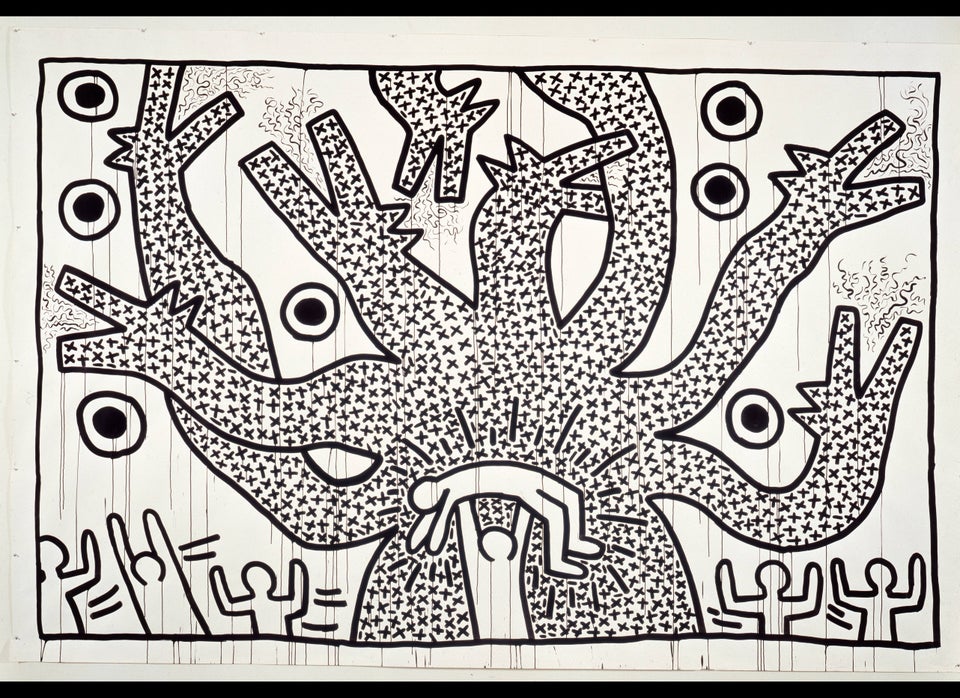Graphic pop artist, human rights activist and visionary curator, Keith Haring was never one for social or creative conventions.
So when one strolls through "Keith Haring: 1978–1982," which opens March 16 at the Brooklyn Museum, it's impossible not to wonder what Haring himself might think of such a prominent display. As if to acknowledge this query, the show's curators feature a series of the late artist's quotes throughout, one of which reads: "The public needs art -- and it is the responsibility of a 'self-proclaimed artist' to realize that the public needs art, and not to make bourgeois art for a few and ignore the masses."
Whether Haring -- heavily criticized during his lifetime for being overly commercial -- ever expected his work to form the basis of an archival retrospective or not, the Brooklyn Museum's exhibition itself is both well-executed and truly comprehensive. The show's curators have wisely looked beyond the cartoonish, almost childlike dancers, flying saucers and barking dogs which have become synonymous with Haring's work (though all are, of course, represented throughout), incorporating notebook sketches, collages, photos videos and other multimedia components which investigate his earlier role as a historical curator and student, in addition to his passion for the vibrant nightlife of New York in the 1980s.
The result is a visually stunning, though surprisingly intimate, look at one of the art world's best-known (and perhaps, most misunderstood) figures to emerge during the latter part of the 20th century. Organizers have also taken great care to show how Haring's frequently mimicked "visual vocabulary" has deeper roots that go beyond its seemingly simple aesthetic.
Take a look at some selected works from "Keith Haring: 1978–1982" below, then scroll down to keep reading:
Haring's lesbian, gay, bisexual and transgender (LGBT) fans may also be excited to see that some of the artist's more explicitly homoerotic works, such as the series of so-called "Manhattan Penis Drawings," which interpreted New York skyscrapers such as the World Trade Center in phallic ways, are also featured in the exhibition.
Though Haring's use of gay images became perhaps less emphasized as he became more commercial, Julia Gruen, who worked as the artist's studio manager from 1984-1990, says that LGBT identity, in addition to "his determination to synthesize music, fashion, dance, club culture and poetry," is partly why his work remains so relevant more than 20 years after his death. (Haring died of AIDS at the age of 31 in February 1990).
"People have come to expect that where Haring is concerned, they have seen all there is to see," Gruen, who became executive director of the Keith Haring Foundation in 1990, a position she holds to this day, told HuffPost Gay Voices. "This exhibition will explode that assumption and reveal Haring as a serious and thoughtful student of art history with a deep curiosity about his own contemporary culture, as well as that of the past."
As for how Haring's work would've specifically envolved had the artist lived, Gruen noted, "Everybody asks, [but] nobody really can say. Likely he would be exploring the positive and negative effects of social media and technology while further experimenting with new media [and] continuing to comment on the social issues that consumed him early on, like racism, violence and sexual identity."
Tricia Laughlin Bloom, project director of the Brooklyn presentation, agreed: "He would have continued to be a connector, bridging the art world and real people."
"Keith Haring: 1978–1982" will continue at the Brooklyn Museum through July 8. For more information, click here.

